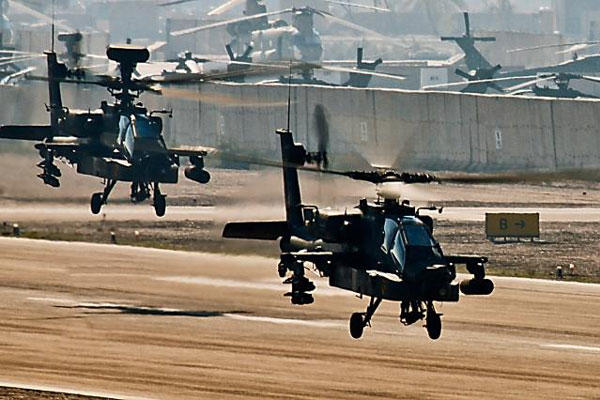The U.S. Army's top officer defended the service's controversial plan to reorganize its helicopter fleets across the active-duty force and National Guard, saying the proposal is being driven by budget cuts.
Under the plan, the Guard would transfer some 400 helicopters, including its entire fleet of about 200 AH-64 Apache attack and roughly 100 OH-58 Kiowa scout choppers, as well as approximately 100 UH-72 Lakota utility aircraft, to the active component. In return, it would receive about 100 more UH-60 Black Hawk utility aircraft.
"This is about affordability," Army Chief of Staff Gen. Raymond Odierno said today during a breakfast organized by the Association of the United States Army, an Arlington, Va.-based educational and advocacy group. "We don't have the money to sustain the system that we have, so we got to make the best use out of the aviation that we have. It's simple. That's the issue. It's nothing else. People want to make it into something it isn't."
The Defense Department faces more than $1 trillion in budget reductions over the next decade, half from automatic cuts known as sequestration. While Congress recently agreed to undo some of the reductions set to take effect in the next two years, the legislation effectively only delayed those cuts until later years.
Odierno said the Army's need to restructure its aviation fleets stems from a $79 billion "bill" the service has to pay over the next five years, "so we have to organize ourselves in the most efficient, effective way possible." The Army is considering scrapping its fleets of Kiowas and Jet Rangers and using the additional Apaches and Lakotas from the Guard for its armed scout and training needs.
The plan has drawn criticism from Guard leaders. The adjutant general of the Tennessee National Guard, Maj. Gen. Max Haston, blasted the idea.
"This will have a tremendously negative impact on the Tennessee Guard," he told the Jackson Sun, a daily newspaper in Jackson, Tenn. "If the Army follows this course of action, Tennessee will lose 30 helicopters and the 692 soldiers who support them. It will also eliminate 113 full-time jobs and possibly two of the three Army flight facilities across the state."
The Army's budget woes were a recurrent theme in Odierno's remarks. Not only can the service not afford its aviation fleet as it exists today, it also can't afford to build a new armed scout helicopter or infantry fighting vehicle, he said.
When asked about Congress's recent decision to cut funding for the Army's future troop carrier, known as the Ground Combat Vehicle, designed to replace the Bradley infantry fighting vehicle, Odierno said, "we're hoping for a follow-on effort."
He and other Army leaders in recent years repeatedly described the program as one of the service's top acquisition priorities. The Army had planned to buy about 1,900 of the vehicles at a cost of as much as $17 million apiece, or $32 billion. But the end of the war in Iraq and the winding down of the war in Afghanistan has eroded support for the effort on Capitol Hill.
Lawmakers last week passed legislation that drastically reduced funding for the program in fiscal 2014, which began Oct. 1, from $592 million to $100 million — a decrease of $492 million, or 83 percent. The move essentially ended the acquisition program, as there isn’t enough money for the Army to move forward by awarding a production contract to one of the two companies working on the technology, General Dynamics Corp. and BAE Systems Plc.
Still, Odierno said the program made "good" progress and hinted that the service is interested in harvesting technology from the developmental effort.
"It's important that we carry that forward," he said.
Despite the pressures on its budget, the Army will continue to invest in replacements for the Humvee utility truck and the M113 armored personnel carrier; upgrades to the Bradley, M1 Abrams tank, Paladin self-propelled howitzer, M4 carbine and battlefield communications network; and improvements to such rotorcraft as the UH-60M Black Hawk, CH-47F Chinook and AH-64D Apache Block III, Odierno said.




























